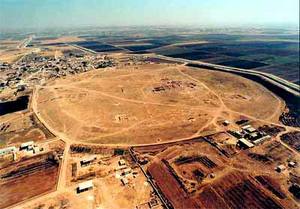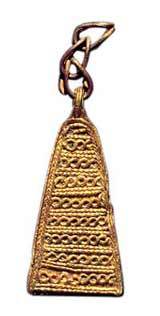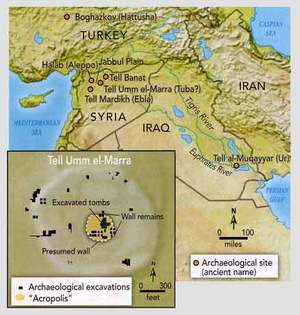
|
| ©Glenn M. Schwartz |
| Aerial view of Tell Umm el-Marra and its surroundings |
In earlier field seasons, our team had whittled away happily at parts of the mound, exploring the residue of a small city founded about 2800 b.c. But on this particular morning I was feeling disappointed. We had begun digging trenches in what we referred to as the "acropolis," a three-and-a-half-acre area at the center of the site. A six-foot-thick wall of mud bricks built around the acropolis in about 1800 b.c. was a tantalizing sign: if ancient inhabitants had taken the trouble to build such a wall, we reasoned, it must have enclosed an important building - a palace, perhaps, or a temple. But when we had dug down to the habitation layer dating from the time of the wall, all we found was a shapeless heap of stone cobbles and boulders.
Disappointed? Yes, but certainly not ready to quit. Could the stones and cobbles still be concealing the foundations of a palace or temple? I asked Alice Petty, a graduate student on our team, to remove the rocks in her trench - after carefully documenting them, of course - and dig deeper. As she did, she uncovered the tops of stone walls that enclosed a rectangular room about twelve feet long by eight feet wide. By the style of the pottery shards in the fill, I judged the room to date from an earlier period. Actually, though, it still didn't look very promising; I rather tepidly suggested to Petty that she keep digging and let me know if anything interesting turned up.
But as she proceeded with the work, my skepticism turned to excitement. Petty started finding unbroken vessels of pottery, which signaled that the contents of the room were unusually well-preserved. Then I heard her call me: "Glenn, there's metal here." I climbed down into the trench to take a look. Two large, lozenge-shaped metal objects were protruding from the soil. Could they be bronze spearheads? One of our colleagues, Sally Dunham, an independent scholar with a special interest in ancient art, came to the edge of the trench to see what was going on. Why would complete vessels and metal objects be found intact inside a room? "Maybe it's a tomb," she suggested. A few strokes with my brush next to the metal objects revealed part of a long bone. I quickly called over Jill Weber, our zooarchaeologist from the University of Pennsylvania, to have a look.
"Animal or human?" I asked her.
"Human."
We summoned our human skeletal expert, Barbara Stuart of the Beirut Archaeological Center, and she began work on what we now understood to be not a room, but a tomb - and a tomb of substantial size. The bones of an adult soon began to emerge, together with objects that had been buried on or near the body. Around the skeleton's neck were beads and amulets of lapis lazuli, the much-prized blue stone from eastern Afghanistan. One of the amulets was carved in the shape of a wild goat, with its horns sweeping elegantly backward. Closer inspection of the metal lozenges, our first find, revealed that they were silver, not bronze, and pierced lengthwise, perhaps for stringing as ornaments.
The next morning Stuart began to uncover a second skeleton. At lunchtime she came into our expedition headquarters, thrilled. Next to the second skeleton she had noticed a thin, gold-colored strip in the soil. Her first thought had been, "What ninny dropped aluminum foil into my excavation?" Then she realized the strip was not modern, but an ancient object made of gold. It proved to be a headband, accompanied by gold beads and a gold bracelet.

|
| ©Glenn M. Schwartz |
| Gold pendant was among the many ornaments discovered in the upper layer of Tomb 1. |
As the days proceeded, a remarkable story began to unfold. The tomb contained three layers of skeletons, undisturbed, as were the rest of the tomb's contents, in the nearly four and a half millennia since they were buried. Ancient tombs containing gold and silver objects tend to be prime targets for robbers, both ancient and modern, and so a pristine tomb is an exhilarating find. In three subsequent excavating seasons (in 2002, 2004, and 2006) we have discovered that "our" tomb, now designated Tomb 1, was not alone, but was part of a large complex devoted to the burial of high-ranking individuals in the mid- to late third millennium b.c.
We have also found clear signs of sacrifice. Next to the tombs we uncovered five smaller enclosures of mud brick that contained the bodies of sacrificed animals and, perhaps, sacrificed infants as well. What we call Installation B, for instance, was a six-foot-square, brick-lined subterranean space containing the headless skeletons of two equids (they could be donkeys or Asiatic wild asses - or perhaps hybrids of the two). The bodies had been interred in a standing position; we found the skulls, along with a spouted jar, on a ledge overlooking the skeletons. After the equids had been positioned, smaller bodies were added to the enclosure: two sets of three puppies, as well as a human infant. The other "installations" contained similar interments of equids, sometimes decapitated, often together with human infants, spouted jars, and puppies. In short, the excavations at Tell Umm el-Marra have yielded a rich trove of material and, given the findings, have raised many questions. Our current inquiries are focusing on two issues: how did the centrally placed tombs function in the community, and why was the tomb complex abandoned and eventually covered over?
Tell Umm el-Marra was first excavated in the late 1970s and early 1980s by a Belgian team directed by the late Egyptologist Roland Tefnin. Those investigations determined the sequence of occupations at the site, which was inhabited most intensively during the third and second millennia b.c. Tefnin also uncovered a number of rooms, as well as a city gate on the northeast side.
Hans H. Curvers, an archaeologist at the University of Amsterdam, and I launched our own joint excavations in 1994. From the beginning, our goal has been to investigate the origins and early development of urban civilization in western Syria. In the standard terms of our profession, we are investigating Bronze Age times, roughly between 3000 b.c. and 1200 b.c. That period, following the widespread adoption of agriculture, is notable not only for the advent of bronze metallurgy (as its name implies), but also for the emergence of writing and, in general, an increase in social stratification. Early urban life in Mesopotamia, the region between the Tigris and Euphrates rivers that some consider the "cradle of civilization," has been well examined, but archaeologists still have a lot to learn about developments in western Syria.
Tell Umm el-Marra, the largest site in the Jabbul Plain, probably functioned as a regional center throughout the Bronze Age [see map below]. It may have been the city known as Tuba, which is first mentioned in texts dating from around 2400 b.c. that were discovered in Ebla, a much larger city to the southwest. Whatever its name in ancient times, though, it was strategically positioned. To the east was a dry steppe frequented by pastoral nomads and, beyond them, the Euphrates River. To the west were rainy agricultural lands, along with the major city of Aleppo. Hence Umm el-Marra were simply more likely to wear ostentatious jewelry than were their male counterparts - as is common in our own society. A woman's showy accoutrements may thus have advertised the wealth or prestige of her family or her husband.
Near the woman in the upper level of Tomb 4 we also discovered seven silver vessels. They are similar in shape to metal vessels found in the royal cemetery of Ur, suggesting that the elites of Syria were imitating the styles of their Mesopotamian counterparts (and maybe vice versa). Owning luxury goods in exotic styles or from exotic places was presumably a good way to display one's high status.
One of the most provocative questions was what to make of the skeletons of animals and infants associated with the tombs. Our conclusion was that rituals featuring animal sacrifice and perhaps even human infant sacrifice accompanied the burials of the adults in the tombs. So who were those adults? I have little doubt that they were the highest-ranking members of their community. Contemporaneous texts from Ebla reveal that high-ranking people were buried with elaborate jewelry of the kind we excavated. In fact, if Umm el-Marra was presided over by independent rulers, the tombs may qualify as royal. At the very least, the individuals buried within them were once members of powerful families.
The sacrificed donkeys or wild asses would have been objects of prestige: contemporaneous texts from Ebla and elsewhere state that such animals drew the war wagons of the elite, and that they were costly. Perhaps the sacrificed animals were intended to transport the deceased to the afterlife, or to serve them in it. Why infant sacrifice was conducted - if it was - is harder to explain. Human sacrifices often accompanied elite burials in such early urban societies as Dynasty I of Egypt, the Shang period of China, and in the Ur royal cemetery, perhaps as a display of raw power.
According to one cuneiform tablet in the Ebla palace archive, the following gold items were among the gifts bestowed by the minister Ibbi-zikir for the funeral of the princess Tarib-damu, priestess of the god Idabal (given the weights, the gold alone would be worth nearly $45,000 in today's market):
4 pectorals, 2 pendants in the shape of a falcon, 28 shekels [a shekel was a little more than a quarter ounce]
1 jug [and] its lid, 19 1/2 shekels
1 goblet, 3 2/3 shekels
2 pins, 20 shekels
2 torques, 39 shekels
159 spherical beads, 22 shekels
120 date-shaped beads, 14 shekels
2 buckles, 6 shekels
1 knot, 4 2/3 shekels
1 necklace, 3 shekels
1 necklace clasp, 3 shekels
2 tassels, 2 shekels
1 thin strip and 1 fringe for a sandal, 4 shekels
2 shekels of gold [for] 1 frontlet, 1 shekel, 1 hairpin, 1 shekel
1 mina [60 shekels] of gold for two reins and four buckles [for equid trappings]
30 shekels of gold to decorate two wheels of a two-wheeled chariot
Excerpt from Text TM.75.G.2334 from the Ebla palace archives, published in Alfonso Archi, "Jewels for the Ladies of Ebla," Zeitschrift für Assyriologie 92 (2002): 161-99. The author thanks Maria Giovanna Biga, of the University of Rome La Sapienza, for assistance in translating the Ebla text.
The tombs also probably acted as constant reminders of the importance of the deceased. After all, they were conspicuous objects in the community - centrally placed, raised up, and at least partly freestanding. The descendants of the dead, by making offerings at the tombs of those interred, may have acquired and maintained their own prestige. Ritual texts from Ebla, which describe offerings made to deceased kings by the living ruler, support that interpretation. In Mesopotamia, by contrast, royal tombs such as the ones at Ur were subterranean and well hidden, suggesting that ancestor veneration was less central, ideologically as well as spatially.
Judging from the small number of bodies in each tomb and the changing styles of pottery, we also infer that power and prestige shifted from one family dynasty to another fairly quickly, in as little as a generation or two. As I noted earlier, many of the tombs were disturbed and then had their entryways blocked with boulders. Groups that attained power may have desecrated the tomb of their predecessors, thereby destroying the link between the living community and the family that was out of favor.
It is unlikely that the perpetrators were either ordinary robbers or family members of the deceased. First, it seems unlikely that robbers would have taken the trouble to block the doorways on their departure. Second, if the tombs had been plundered by robbers, then resealed by community members who valued the interred people, an effort would have been made to tidy things up inside the tombs. But the interiors were left in disarray.
Around the end of the Early Bronze Age, about 2000 A, many Syrian cities shrank in size or were abandoned altogether. The reason for the apparent collapse is a subject of vigorous debate. Some point to abrupt climatic change, others to human-induced environmental degradation. We have studied both botanical and faunal remains for clues, but so far we have no satisfactory answer. What we can say is that parts of Umm el-Marra were abandoned, and many nearby settlements were deserted as well.
Then, around 1800 A, there was a resurgence of the community, probably related to the rise of a powerful kingdom based at Aleppo. An energetic program of public works was undertaken at Umm el-Marra, including new earth and cobble ramparts encircling the site and a mudbrick city wall on top. In that same era, the "acropolis" was enclosed with its thick wall, and the tombs were covered over by the heap of rocks I had found so disappointing.
In the fourteenth century b.c., Umm el-Marra fell victim to an episode of substantial destruction: some buildings were burned, with some of their household implements, luxury items, and other contents still inside. The timing suggests a link with the onslaught on western Syria by King Suppiluliuma I, whose domain was centered in Boghazkoy, in present-day Turkey. By 1200 b.c., the end of the Late Bronze Age, Umm el-Marra was abandoned, at least as a city. Although no one has yet proved that Umm el-Marra was the site of the city of Tuba, that period is also the latest in which Tuba is mentioned in ancient texts.
The mound on the Jabbul Plain was reoccupied from time to time thereafter, most substantially between about 500 and 200 b.c. Those who came that late, however, would not have known about the tombs, by then hidden and forgotten. The people buried within were left for archaeologists to discover. In a way, then, we are the first who can restore to them a small measure of the glory they once claimed.




Reader Comments
to our Newsletter